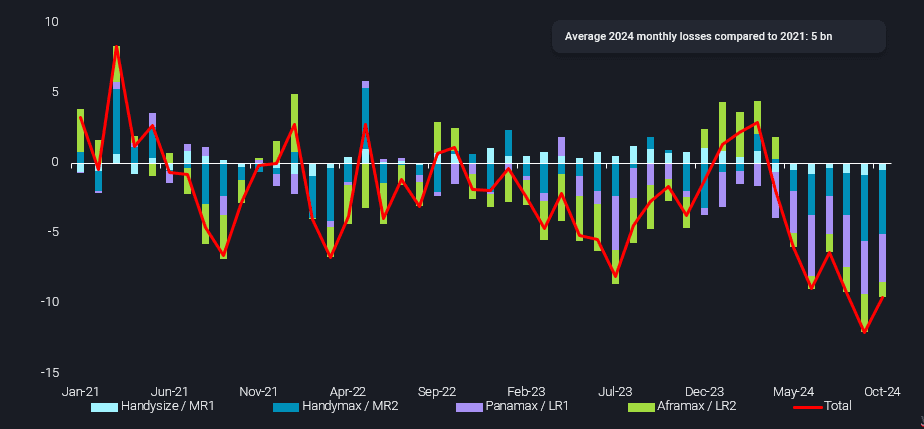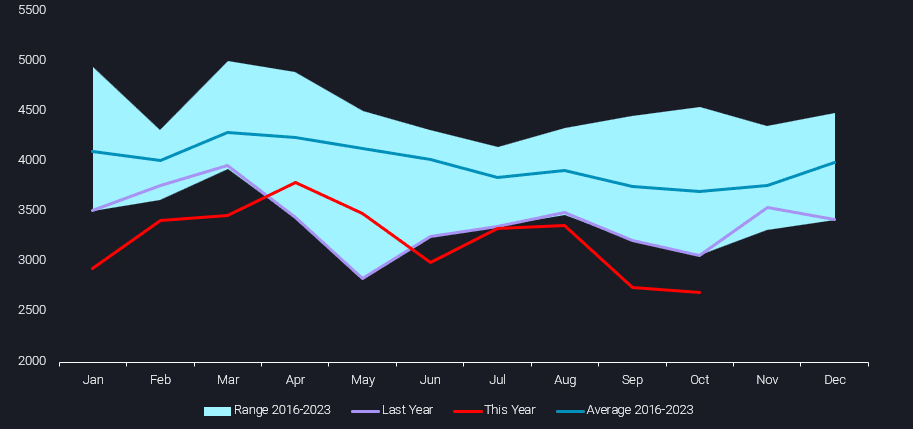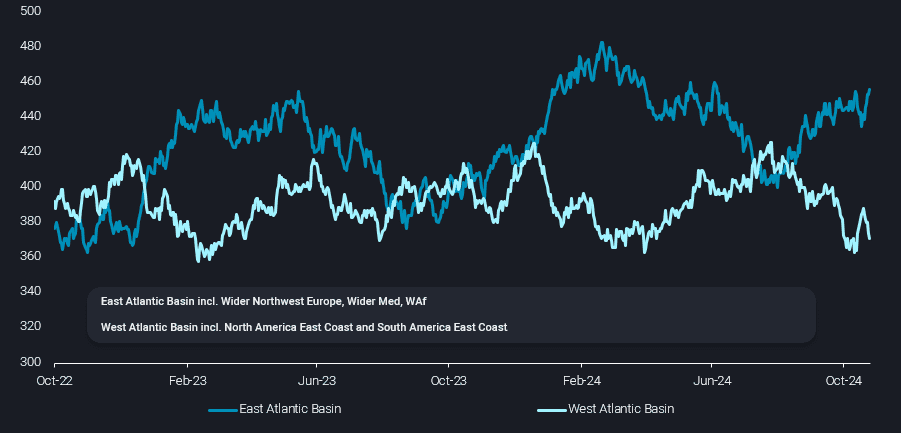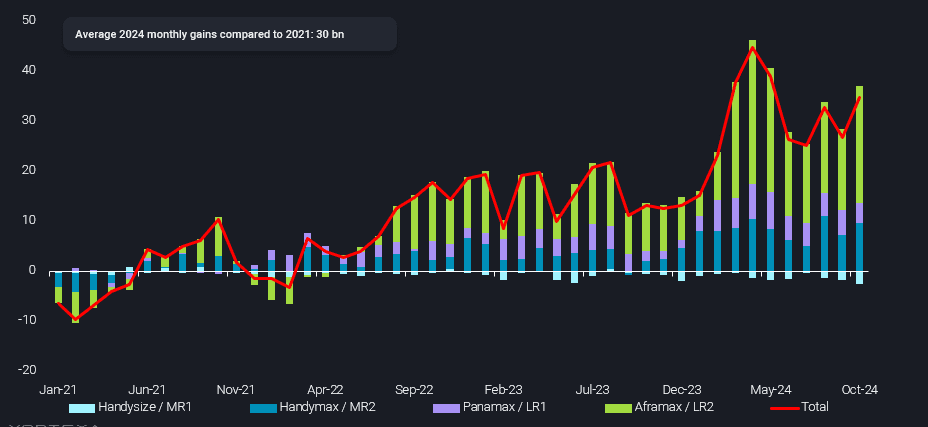LR2s poised to benefit from structural change to Europe’s clean tanker market
As Europe’s refining landscape remains under pressure, we look at what this could mean for the clean tanker market.
The Wider European refining landscape is under pressure. Margins have suffered due to high volumes of middle distillates arriving from the Wider Arabian Sea, plus robust diesel imports from the US and Russia. In the export market, PADD 1’s demand for European gasoline has been at seasonal record-low levels over the last few months. In WAf, even before the Dangote refinery has started producing its full output of 300kbd of gasoline (virtually all of WAf’s current gasoline import volume), WAf’s imports of Europe’s gasoline have continued falling since early 2023. Additionally, lower crude arrivals in Core Europe over the last six months are a sign of pressure on refiners. All of these factors point to European refineries being in a tricky position, which makes the possibility of extended economic run cuts and shutdowns beyond what have already been announced for next year not unlikely.
This pressure on the refining landscape is not all bad news for the clean tanker market, with the larger vessel classes standing to gain most.
MR2s: Low voyage mileage, arrivals of TA diesel increase vessel supply-side pressure as Europe’s gasoline exports decline
From an export perspective, a lack of gasoline exports from Europe has hammered MR2s with an average loss of 1.8bn tonne-miles each month in 2024 (Jan-Oct) compared to 2021. Losses in LR1 tonne-miles for naphtha to the East have also been a factor, but the hit to MR2 tonne-miles in the gasoline trade is significant, especially as TC2 is the traditional front-haul route for Atlantic Basin MRs.
A consequence of falling MR2 demand for voyages out of Europe has been a sharp decline in MR2 voyage mileage out of NW Europe. Mileage in October was observed at an all-time low, after hitting seasonal lows for most months of this year. A lack of voyages towards North America or WAf and increased short-haul voyages within Europe resulted in the sharp drop.
Low mileage kept vessel supply in Europe elevated, and further supply-side pressure has been exerted from two factors: tankers in the Med which left the Russian trade throughout the spring and summer due to lack of demand from reduced diesel exports, and high arrivals of vessels from the Gulf of Mexico due to arbitrage opportunities on TC14.
These developments have driven a vessel supply-shift from the “West” Atlantic Basin (North and South America) to the “East” Atlantic Basin (Wider NW Europe, Wider Med, WAf). Demand fundamentals in the “East” are currently at odds with the supply-side, explaining the low levels of MR freight rates.
For voyages into Europe, MR2s gained on average 8.3 bn tonne-miles each month this year compared to 2021, mostly from high TA diesel arrivals. It is likely that volumes of PADD 3 diesel coming to the European market will remain robust if US consumption remains low and pushes volumes TA. TC14 could become the main fronthaul route in the Atlantic Basin market, especially as demand for European gasoline is undergoing a structural decline.
Moving forward, relief could come for MR2s in Europe because we expect a seasonal return of Russian diesel exports, which are already increasing. This should absorb tonnage that is pressuring the Europe/Med market, as these vessels can move in and out of the Russian trade due to Russian diesel remaining under the price cap. It is also likely that we will continue to see MR2s muscle out smaller vessels (handysize), from short-haul intra-European trade as traditional MR2 trading opportunities in the Atlantic dry up.
LR2s benefit from East-to-West middle distillate flows, especially as Red Sea diversions continue to keep tonne-miles elevated
The real winners from the change in European flows are the LR2s. From an arrivals basis into Europe, CPP tonne-miles in 2024 are up on average 30bn each month compared to 2021. 18 bn of these gains have come from LR2s. Tonne-mile gains were even more weighted towards LR2s earlier this year when voyages around the Cape of Good Hope for E-W middle distillate cargoes on LR2s peaked. Cleaned-up supertankers (VLCCs and Suezmaxes) cut LR2 tonne-miles to Europe in July and August. As the clean-up trend slows down due to the seasonal return of crude tanker demand, a strengthening fuel oil market and lower LR2 rates from the MEG, tonne-miles on LR2s to Europe have picked up again.
Currently, because Europe is saturated with diesel, there may not be further increase in the short-term in East-to-West LR2 voyages around the Cape of Good Hope. However, voyage counts are already high, and Europe’s jet demand appears healthier, so we can still expect to see robust tonne-mile demand.
In the medium- to long-term, we are seeing a structural change that favours LR2s the most in terms of Europe’s middle distillate demand, as Europe is a market which will continue to be short on middle distillates. With the above-mentioned pressures on the European refinery landscape, the continent will likely turn more to middle distillate supplies from the Wider Arabian Sea. Economies of scale make large parcels on bigger vessel classes attractive to buyers, especially as India (one of the key Wider Arabian Sea suppliers) takes Russian crude at a discount. Additionally, there are no indications the Houthi attacks in the Red Sea will stop any time soon, which will continue to mean the East-to-West route for middle distillates to Europe is very high on tonne-miles.



